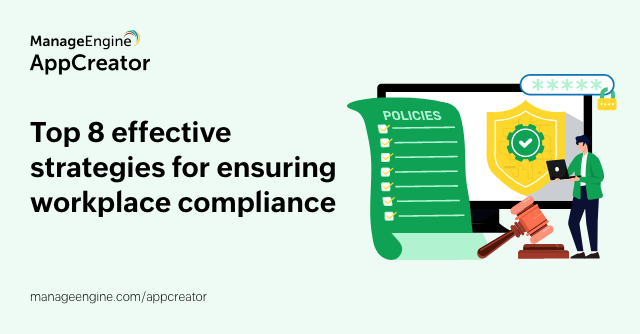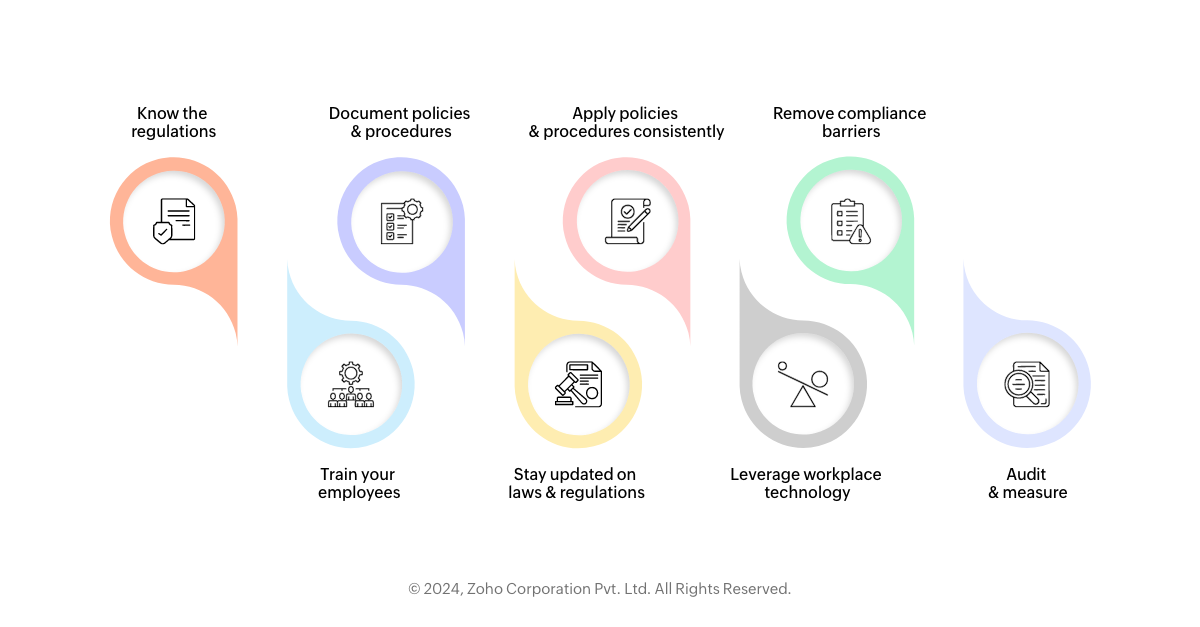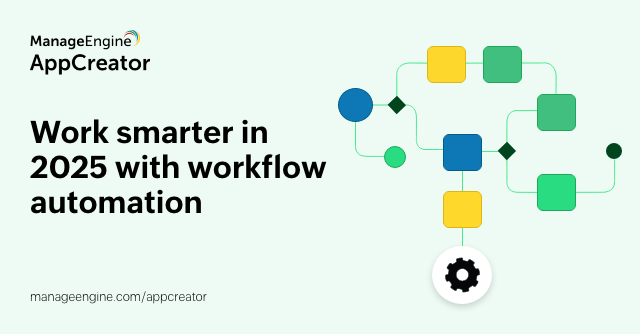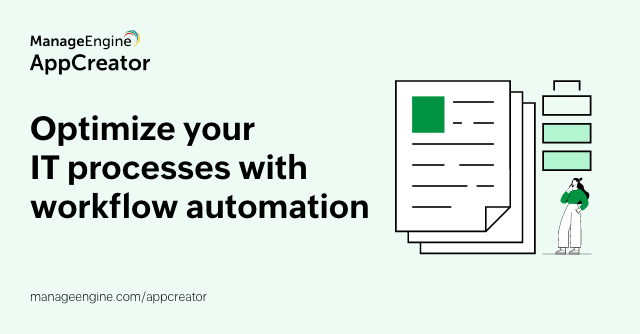- HOME
- Workflow automation
- Top 8 ways to ensure compliance in the workplace
Top 8 ways to ensure compliance in the workplace
- Last Updated: November 1, 2024
- 921 Views
- 6 Min Read

Workplace compliance isn't just about following rules; it's about creating a safe, ethical, supportive environment for everyone. Compliance encompasses adherence to laws, regulations, standards, and internal processes that govern how organizations operate. One pressing issue in this context is mental health, an area that has gained significant attention in recent years. According to the World Health Organization, 15% of working-age adults in 2019 were estimated to have a mental disorder.
This alarming figure highlights the importance of workplace compliance, especially in areas such as mental health support, safety, and fair treatment. Ensuring compliance not only keeps organizations in line with laws and regulations but also fosters a healthier, more productive work environment, ultimately benefiting both employees and organizations as a whole.
Why is workplace compliance important?
Workplace compliance is important as it ensures that your organization is aligned with legal and ethical standards, preventing lawsuits and potential financial penalties. It's also essential for maintaining a safe, fair work environment for all employees, fostering trust and accountability. Here are a few reasons to support the cause:
To avoid legal issues: Organizations that fail to comply with labor laws can face lawsuits. For example, the United States Equal Employment Opportunity Commission reported that in 2020, employers paid $439 million in monetary benefits to victims of discrimination.
“If companies do not have a financial incentive to comply with the minimum wage, it creates a race to the bottom dynamic. Companies that want to comply with the law and pay their workers fairly may be outcompeted."
Anna Stansbury, Class of 1948 Career Development Assistant Professor
To ensure safety: Compliance with safety regulations like OSHA standards significantly reduces workplace injuries. According to OSHA, companies that implement effective safety programs can see up to a 40% reduction in workplace injuries.
To build trust: Transparency in compliance fosters trust. According to a survey by Personio, 59% of employees in the United Kingdom believe their organization should enhance openness and transparency regarding pay and rewards, and 61% feel this would positively impact their view of their organization.
8 ways to ensure compliance in the workplace

1. Know the regulations
The first step to workplace compliance is understanding the rules. Different industries have different sets of regulations, so it’s crucial to identify the ones that apply to your organization.
For example, if your business deals with data, you need to ensure compliance with data protection regulations like the GDPR or CCPA. If you’re in healthcare, adhering to HIPAA guidelines is mandatory. The point here is that you cannot ensure compliance if you don’t know what you're supposed to comply with. Failing to comply can leave your organization vulnerable to adverse legal consequences.
2. Document policies and procedures
Once you know the rules, the next step is documenting them via clear, actionable policies and procedures. A well-documented set of compliance guidelines ensures that everyone in the organization is on the same page.
For instance, your company's data handling procedures should be clear, concise, and available to all the employees who work with sensitive information, like HR or legal team members. Documenting policies also allows for easier training, and employees can refer to these documents when questions arise. Moreover, having clear documentation reduces ambiguity and provides a basis for effective auditing later.
3. Apply policies and procedures consistently
Consistency is key when it comes to compliance. It's not enough just to have policies; you need to apply them uniformly across the organization. Inconsistent rule application can lead to confusion, favoritism, or even legal complications.
A consistent approach to applying policies ensures that all employees are held to the same standards, fostering fairness in the workplace. Consistency can also enhance accountability because employees know that any deviation from policies has consequences.
4. Remove compliance barriers
Sometimes, policies may be difficult to follow because of practical constraints. To ensure compliance, it's essential to address these constraints. This could mean making compliance processes more intuitive or providing employees with tools that make following regulations easier.
For example, if data entry is part of your compliance requirements, but your software is outdated or difficult to use, your employees may inadvertently skip crucial steps. Modernizing your systems, introducing automation where necessary, or offering easy-to-understand guidelines can reduce the risk of noncompliance.
5. Train your employees
Even with the best policies in place, compliance is difficult to achieve without proper training. Employees must be educated on the policies they need to follow, why those policies are important, and what the consequences of noncompliance are.
Regular training sessions ensure that employees are aware of their responsibilities, how to handle situations that might pose compliance risks, and how to report violations. Moreover, training should be an ongoing process, not just a one-off event. New regulations and company policies emerge all the time, so regular refreshers keep everyone up to date.
6. Stay updated on laws and regulations
Laws and regulations aren’t static; they regularly change, and your compliance efforts must evolve accordingly. Whether you're handling labor laws, health and safety guidelines, or cybersecurity regulations, staying on top of these changes is crucial.
You can stay updated by regularly consulting legal experts, attending webinars, or following relevant newsletters. If your organization fails to stay updated, it will be at risk of falling out of compliance, which could lead to fines, lawsuits, and reputational damage.
7. Leverage workplace technology
One of the most effective ways to ensure workplace compliance is using technology. Tools like ManageEngine AppCreator, a low-code platform that lets you build and customize solutions with minimal coding expertise, can automate various compliance tasks, making it easier to track, enforce, and report on compliance efforts.
For instance, you can use technology to automate the audit process, ensure that policies are applied uniformly across departments, and monitor employee training records. Compliance software also creates digital audit trails, which can be invaluable during inspections or internal reviews. By leveraging the right technology, you can implement automated alerts, centralized data management, real-time monitoring, comprehensive reporting, and digital audit trails, ensuring that nothing slips through the cracks while also saving time and reducing human error.
8. Audit and measure compliance
Finally, no compliance strategy is complete without regular audits and measurements of your adherence. Audits help you identify gaps in your compliance efforts and ensure that your policies are being followed correctly. Measuring compliance also allows you to assess your overall adherence to regulations and the effectiveness of your training programs and policy implementation.
It's important to set up a system for tracking compliance metrics, such as the number of reported violations, the time it takes to resolve them, and employee engagement with compliance training. Continuous measurement allows for ongoing improvements, ensuring that your workplace stays compliant in the long run.
How AppCreator helps ensure workplace compliance
AppCreator is a low-code platform that empowers you to create custom applications tailored to your organization's specific compliance needs without requiring extensive technical expertise. Here’s how it helps:
Custom workflows for compliance: With AppCreator, you can design workflows that automate compliance tasks like documentation, employee training reminders, and policy updates. For example, if your business is subject to new data protection laws, you can build a workflow that alerts employees and updates internal policies in real time.
Real-time auditing: The platform provides real-time insights into compliance, allowing managers to track who has completed training, who is following the rules, and where gaps exist. These audits can be automated and scheduled to run regularly to ensure that compliance efforts are consistent.
- Easy reporting: Reporting is a critical part of compliance, especially when external regulators are involved. AppCreator simplifies this process by enabling automated report generation based on real-time data. You can quickly provide documentation on compliance measures for external audits or internal reviews with minimal manual intervention.
Document management: Store all your compliance policies, procedures, and legal documents in one centralized location that’s easy to access and update. This feature ensures that your employees always have the most current information, reducing the risk of outdated policies being followed.
Training management: You can set up custom applications to track employee training on compliance-related topics. The platform makes it easy to send reminders, track progress, and ensure that all employees complete mandatory compliance training sessions.
If you're interested in exploring the possibilities of this software, feel free to share your requirements, and we can build you a free proof of concept.



